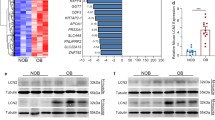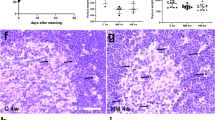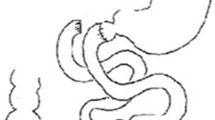Abstract
Lipoapoptosis has been described in many organs and tissues, but never in enterocytes. We hypothesized that a high saturated-fat diet can induce duodenal enterocyte apoptosis and impair gastric inhibitory polypeptide (GIP) secretion. Forty male Wistar rats, ∼4 months old, were randomized on standard laboratory or purified tripalmitin-based high-fat diet (59% calories). An oral-glucose tolerance test was performed after 30 and 90 days of diet to measure plasma glucose, insulin and GIP. Duodena were processed for histology and immunohistochemistry by transferase-mediated dUTP nick end-labeling (TUNEL) method. Apoptosis was confirmed by enzyme-linked immunosorbent assay. Glycemic response was significantly higher (P<0.01 vs controls) in rats after 90 days. Insulin curve was markedly increased at 30 days, while it was blunted at 90 days. GIP area under the curve was 425.6±67.6 ng ml−1 at 30 days vs 150.2±33.4 ng ml−1 in controls (P<0.001) and dropped to 53.8±25.8 ng ml−1 at 90 days (P<0.0001). TUNEL-positive nuclei were 66.08±26.19 at 30 days 57 (34.58±17 in controls, P<0.05) and 216.99±129.42 nuclei per mm3 at 90 days (38.75±18.36 in controls, P<0.0001). A high saturated-fat diet stimulates GIP secretion but with time induces apoptosis of duodenal villi epithelium, showing for the first time that enterocytes are also prone to lipoapoptosis. The reduction of circulating GIP levels might contribute to hypoinsulinemia and hyperglycemia.
This is a preview of subscription content, access via your institution
Access options
Subscribe to this journal
Receive 12 print issues and online access
$259.00 per year
only $21.58 per issue
Buy this article
- Purchase on Springer Link
- Instant access to full article PDF
Prices may be subject to local taxes which are calculated during checkout

Similar content being viewed by others
References
Unger RH . The physiology of cellular liporegulation. Annu Rev Physiol 2003; 65: 333–347.
Mortensen K, Christensen LL, Holst JJ, Orskov C . GLP-1 and GIP are colocalized in a subset of endocrine cells in the small intestine. Regul Pept 2003; 114: 189–196.
Miyawaki K, Yamada Y, Yano H, Niwa H, Ban N, Ihara Y et al. Glucose intolerance caused by a defect in the entero-insular axis: a study in gastric inhibitory polypeptide receptor knockout mice. Proc Natl Acad Sci USA 1999; 96: 14843–14847.
Lauritsen B, Holst JJ, Moody AJ . Depression of insulin release by anti-GIP serum after oral glucose in rats. Scand J Gastroenterol 1981; 16: 417–420.
Thomas FB, Mazzaferri EL, Crockett SE, Mekhjian HS, Gruemer HD, Cataland S . Stimulation of secretion of gastric inhibitory polypeptide and insulin by intraduodenal amino acid perfusion. Gastroenterology 1976; 70: 523–527.
Falko JM, Crockett SE, Cataland S, Mazzaferri EL . Gastric inhibitory polypeptide (GIP) stimulated by fat ingestion in man. J Clin Endocrinol Metab 1975; 41: 260–265.
Ohneda A, Kobayashi T, Nihei J . Response of gastric inhibitory polypeptide to fat ingestion in normal dogs. Regul Pept 1984; 8: 123–130.
Newsholme P, Keane D, Welters HJ, Morgan NG . Life and death decisions of the pancreatic beta-cell: the role of fatty acids. Clin Sci 2007; 112: 27–42.
Dalla Libera L, Ravara B, Angelini A, Rossini K, Sandri M, Thiene G et al. Beneficial effects on skeletal muscle of the angiotensin II type 1 receptor blocker irbesartan in experimental heart failure. Circulation 2001; 103: 2195–2200.
Yasuhara S, Perez ME, Kanakubo E, Yasuhara Y, Shin YS, Kaneki M et al. A skeletal muscle apoptosis after burns is associated with activation of proapoptotic signals. Am J Physiol Endocrinol Metab 2000; 279: E1114–E1121.
Lewis JT, Dayanandan B, Habener JF, Kieffer TJ . Glucose-dependent insulinotropic polypeptide confers early phase insulin release to oral glucose in rats: demonstration by a receptor antagonist. Endocrinology 2000; 141: 3710–3716.
Wideman RD, Kieffer TJ . Glucose-dependent insulinotropic polypeptide as a regulator of beta cell function and fate. Horm Metab Res 2004; 36: 782–786.
Author information
Authors and Affiliations
Corresponding author
Rights and permissions
About this article
Cite this article
Gniuli, D., Dalla Libera, L., Caristo, M. et al. High saturated-fat diet induces apoptosis in rat enterocytes and blunts GIP and insulin-secretive response to oral glucose load. Int J Obes 32, 871–874 (2008). https://doi.org/10.1038/ijo.2008.9
Received:
Revised:
Accepted:
Published:
Issue Date:
DOI: https://doi.org/10.1038/ijo.2008.9
Keywords
This article is cited by
-
Nonlinear transcriptomic response to dietary fat intake in the small intestine of C57BL/6J mice
BMC Genomics (2016)
-
Indomethacin suppresses LAMP-2 expression and induces lipophagy and lipoapoptosis in rat enterocytes via the ER stress pathway
Journal of Gastroenterology (2015)
-
C57Bl/6 N mice on a western diet display reduced intestinal and hepatic cholesterol levels despite a plasma hypercholesterolemia
BMC Genomics (2012)
-
High-fat feeding stimulates endocrine, glucose-dependent insulinotropic polypeptide (GIP)-expressing cell hyperplasia in the duodenum of Wistar rats
Diabetologia (2010)



